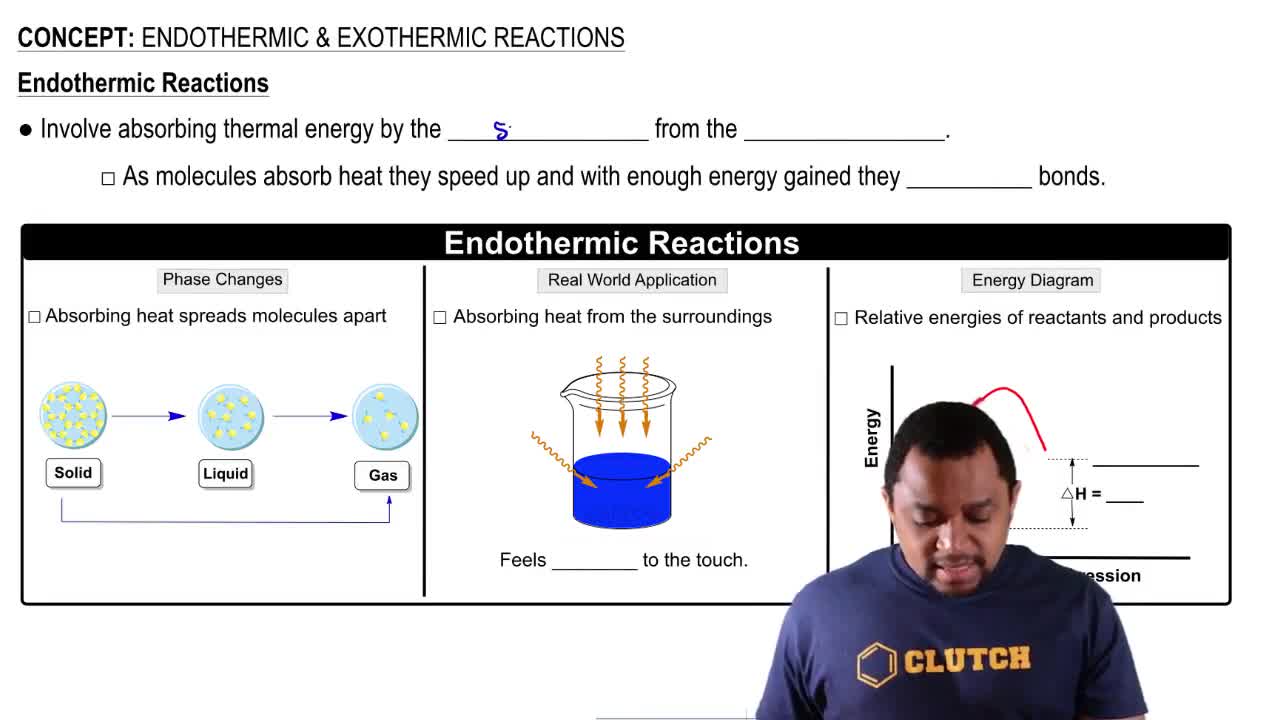Consider the following equilibrium between oxides of nitrogen 3 NO(g) ⇌ NO2(g) + N2O(g) (a) At constant temperature, would a change in the volume of the container affect the fraction of products in the equilibrium mixture?
Ch.15 - Chemical Equilibrium
Chapter 15, Problem 66b
Methanol (CH3OH) can be made by the reaction of CO with H2: CO(𝑔) + 2 H2(𝑔) ⇌ CH3OH(𝑔) (b) To maximize the equilibrium yield of methanol, would you use a high or low temperature?
 Verified step by step guidance
Verified step by step guidance1
Understand the nature of the reaction: The reaction CO(g) + 2 H2(g) ⇌ CH3OH(g) is an exothermic reaction, meaning it releases heat.
Recall Le Chatelier's Principle: This principle states that if a system at equilibrium is subjected to a change in concentration, temperature, volume, or pressure, then the system will adjust itself to counteract that change and restore a new equilibrium.
Apply Le Chatelier's Principle to temperature: Increasing the temperature of an exothermic reaction will shift the equilibrium to the left, favoring the reactants. Conversely, decreasing the temperature shifts the equilibrium to the right, favoring the formation of products.
Determine the effect of temperature on yield: Since the formation of methanol (CH3OH) is exothermic, lowering the temperature will shift the equilibrium towards the right, increasing the yield of methanol.
Conclusion on optimal conditions: To maximize the equilibrium yield of methanol in this reaction, a low temperature should be used.

Verified video answer for a similar problem:
This video solution was recommended by our tutors as helpful for the problem above.
Video duration:
5mWas this helpful?
Key Concepts
Here are the essential concepts you must grasp in order to answer the question correctly.
Le Chatelier's Principle
Le Chatelier's Principle states that if a dynamic equilibrium is disturbed by changing the conditions, the position of equilibrium shifts to counteract the change. In the context of the methanol synthesis reaction, altering temperature can influence the equilibrium position, favoring either the reactants or products depending on whether the reaction is exothermic or endothermic.
Recommended video:
Guided course

Le Chatelier's Principle
Exothermic and Endothermic Reactions
Reactions can be classified as exothermic or endothermic based on heat exchange. An exothermic reaction releases heat, while an endothermic reaction absorbs heat. The methanol synthesis reaction is exothermic, meaning that lowering the temperature would favor the formation of methanol, as the system will shift to produce more heat.
Recommended video:
Guided course

Endothermic & Exothermic Reactions
Equilibrium Constant (K)
The equilibrium constant (K) quantifies the ratio of concentrations of products to reactants at equilibrium for a given reaction at a specific temperature. Changes in temperature can alter the value of K, thus affecting the yield of products. For the methanol synthesis reaction, a lower temperature increases the equilibrium constant, favoring the production of methanol.
Recommended video:
Guided course

Equilibrium Constant K
Related Practice
Textbook Question
Textbook Question
Methanol (CH3OH) can be made by the reaction of CO with H2: CO(𝑔) + 2 H2(𝑔) ⇌ CH3OH(𝑔) (a) Use thermochemical data in Appendix C to calculate ΔH° for this reaction.
Textbook Question
Methanol (CH3OH) can be made by the reaction of CO with H2: CO(𝑔) + 2 H2(𝑔) ⇌ CH3OH(𝑔) (c) To maximize the equilibrium yield of methanol, would you use a high or low pressure?
Textbook Question
Ozone, O3, decomposes to molecular oxygen in the stratosphere according to the reaction 2 O3(𝑔) ⟶ 3 O2(𝑔). Would increasing the pressure by decreasing the size of the reaction vessel favor the formation of ozone or of oxygen?
Textbook Question
(a) Is the dissociation of fluorine molecules into atomic fluorine, F2(𝑔) ⇌ 2 F(𝑔), an exothermic or endothermic process?
